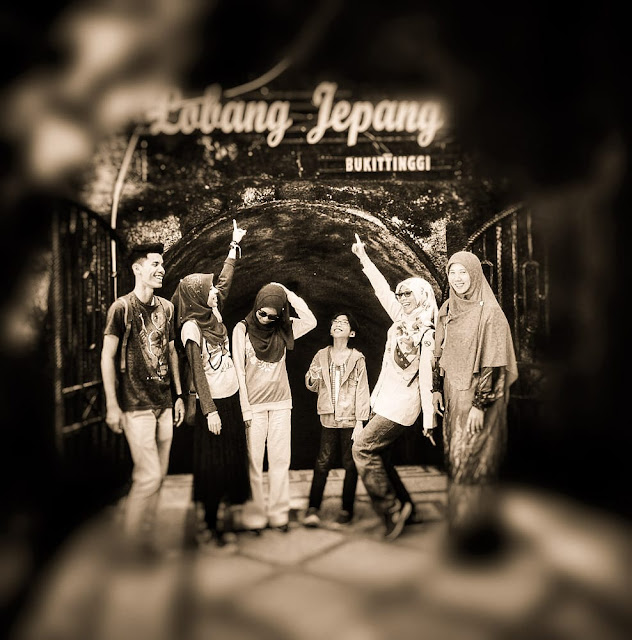[JAPANESE TUNNEL, BUKIT TINGGI] - Abominable history, excrutiating memory
 |
| Candid photo taken by our supir! eheh |
Japanese Tunnel was built on 1942 until 1943 by forced labourer when Japan occupied Indonesia for two years and eight months. Along that period, thousands were killed, tortured and no exact figures can be concluded.
 |
| View from one of the tunnels. It looks a bit creepy isn't it? |
 |
| Thousands were locked here and they were abandoned to die. Normally they were the forced labourers who were brave enough to go against the Japanese army |
I stunned when the tour guide explained in details on the army's strategies in building the cave. They are very wise that I believe no one can argue that, the engineering skills are so effective and interesting for us, the new generation to study.
Bukit Tinggi is a strategic location as it connects three volcanoes which are Gunung Merapi, Gunung Singgalang and Gunung Sago. Having control of Bukit Tinggi could be a huge credit to the Japanese army as they could control the other regions as well resulted to the whole of West Sumatra. For example, Gunung Singgalang is accessible to Medan while Gunung Sago is accessible to Payakumbuh and Pekan Baru.
Bukit Tinggi is a strategic location as it connects three volcanoes which are Gunung Merapi, Gunung Singgalang and Gunung Sago. Having control of Bukit Tinggi could be a huge credit to the Japanese army as they could control the other regions as well resulted to the whole of West Sumatra. For example, Gunung Singgalang is accessible to Medan while Gunung Sago is accessible to Payakumbuh and Pekan Baru.
Most of the laborers were Javanese and not among the local people in Bukit Tinggi. Nonetheless, people from Bukit Tinggi were sent to Java Island for the force labour as well. This was done to secure the secret information and to prevent the news spreading among the local people that a bunker was made! Labourers from other region didn't have relatives to talk to and they also had troubles communicating with one another. Even, all the works were done at night and no one knew nothing but the people who involved in that process.
 |
| The floor at the escape room is a bit higher compared to the main tunnel. And everything was done for a reason! |
The bunker consists 26 rooms that served different purposes. They were ammunition room, escape room, emergency room, torture room, prison and meeting room. We visited the exit tunnel / emergency room and found the floor is a bit higher than the major alley. Do you know why? Because Japan could run as fast as they could if their tunnel got discovered while Holland people might take some time to chase them as they are taller than Japanese army. Hence, they had to crouch while running.
To keep track of the forced laborers' work, Japanese army had a traditional measurement. If you notice in the picture, the walls were dented, forming a concave shape. It was to determine of how much work that the workers had done. If the labourers did not reach their target, they could get beaten. Just so you know the forced labourers used traditional tools in making the bunker, such as chisel and hammer. Other than that, the dent at the wall prevent the voices from echoing. Thus, no matter how loud you scream, yell, cry, no one can hear you.
The picture above shows the kitchen. But it was not a place to cook, in fact it was a place for them to torture the labourers. The flat cement where Mom and Brother sat was where the prisoners were laid before they chopped off their heads. The bodies were dumped into the hole below while the heads were used to build bridges. They believe the heads could strengthen their buildings. Meanwhile, the hole at the above was used to spy the locals' activities. Rice, vegetables and fruits were taken from them for their food in the cave.
After Japan surrendered to United Nations, the labourers were sprayed with poisonous gas from behind, no actual numbers can be estimated on how many were killed.
 |
| Can you see the wall of the cave was dented at every 1 metre, it was to keep track of the laborers' work. |
The picture above shows the kitchen. But it was not a place to cook, in fact it was a place for them to torture the labourers. The flat cement where Mom and Brother sat was where the prisoners were laid before they chopped off their heads. The bodies were dumped into the hole below while the heads were used to build bridges. They believe the heads could strengthen their buildings. Meanwhile, the hole at the above was used to spy the locals' activities. Rice, vegetables and fruits were taken from them for their food in the cave.
 |
| Most of the surfaces of the bunker were already cemented, but some are left original, like this yellowish wall. |
Holland invaded Indonesia for about 350 years and none of the locals wore jute as their daily clothes and ate porridge with cassava. But everything changed when Japan came to Indonesia only for 2 years and 8 months, not only that, thousands were killed and if Nagasaki and Hiroshima's tragedy did not happen, I believe we would still be living in their grips of relentless cruelty.
-Tourist guide-



Comments
Post a Comment